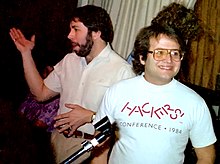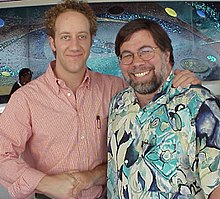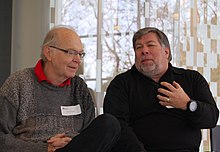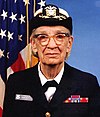Steve Wozniak
Stephen Gary "Steve" Wozniak , also known as "The Woz" , (born August 11, 1950 in Sunnyvale , California ) is an American computer engineer and freelance entrepreneur . He was a prominent member of the Homebrew Computer Club , known as the "melting pot for an entire industry," from which numerous computer companies have sprung - including Apple , which Wozniak and his friend Steve Jobs founded in 1976 with Ron Wayne .
He played a key role in the development of the PC and, with the Apple I, developed the first mass-produced personal computer affordable for private households. Together with the successor Apple II , these are the last computers in series that were designed by a single person. Wozniak also developed the computer game Breakout .
Life
youth
Wozniak is the son of Margaret Elaine and Jacob Francis Wozniak and has Polish ancestors. His father worked as an engineer at Lockheed and frequently supported his son with his inventions and appraised them. Tom Swift , the hero of a series of adventure novels , also had an influence . Wozniak saw him as the product of creative freedom, scientific knowledge and the ability to find a solution to any problem.
In his intellectual development, the preoccupation with ethical and moral questions and philosophy played an important role, as well as the maxim of radio amateur ethics to help people in need, as well as the utilitarian and humanitarian attitude that dominates in the Tom Swift books . Later he was also shaped by the political conflicts over the Vietnam War .
He learned the basics of mathematics and electronics from his father . When Wozniak was eleven years old, he built his own amateur radio station and received an amateur radio license with the callsign WA6BND, which is no longer assigned to him. He was elected President of the Electronics Club at Homestead High School in Cupertino , California .
In 1963, at the age of 13, he won first prize in a school competition with a self-made transistor- based calculator . At the same age, he began designing his first computers, which paved the way for his later successes. One of these computers could play tic-tac-toe . Since he didn't have enough money to buy a lot of components, he began to redesign existing computers with as few microchips as possible in order to make them affordable. However, he was too shy to ask chip companies about microchips in order to be able to realize his computers.
Education
During his student days, he devoted himself to building a TV jammer with which he played various pranks on his fellow students. At the age of 19 he developed the Cream Soda Computer with his friend Bill Fernandez and the support of the manager Bill Werner, who got him the chips . When the computer was ready, Wozniak's mother called the press, but when the reporter arrived, the reporter tripped over a cable and the entire computer went up in smoke. The article appeared anyway. This computer represented a milestone for Wozniak. The computer was on the one hand at the level of the available kits and on the other hand he was more or less built by himself. In addition, the Cream Soda computer was a reason for meeting Steve Jobs . When the computer was finished, Bill Fernandez arranged for the two of them to meet, as they were both interested in electronics. They met at Bill's, talked directly over the computer, and became good friends.
Phreaking
In an issue of Esquire , Wozniak discovered a story about a blue box that made it possible to make free phone calls. To do this, you had to call a free number, "take over" the line using a special tone and dial by tones. He met with John T. Draper alias Capt'n Crunch, the discoverer of this phreaking method, and had the technical background explained to him. Together with Steve Jobs, he started selling self-made blue boxes. For Wozniak, however, the focus was not on free phone calls, but on the fact that he was able to exploit a bug in the system - which can be seen as a typical hacker's attitude . The increasing spread of the blue box and of replicas finally caused the American telephone company AT&T to change the technology of its telephone network nationwide.
Hewlett-Packard

After Steve Wozniak left Berkeley in June 1972, he started working for the small company Electroglas. After half a year, in January 1973, he switched to HP as an engineer . Here he met his friend Allen Baum again, who was doing an internship there. Baum told Wozniak about the work in his group that had worked on the HP-35 calculator . The HP-35 was the world's first technical and scientific pocket calculator with trigonometric , logarithmic and exponential calculation functions . Wozniak then began to work for Hewlett-Packard on the development of other pocket calculators, he had seen the sales launch of the HP-35 while still in college. He later described HP as an outstanding company in terms of technical innovation and product quality, but also in terms of social relationships between colleagues.
However, his passion was still computer development. In his spare time he also developed video games. When he visited Steve Jobs, who meanwhile worked at Atari , there and presented his development to those present, Atari immediately offered him a job. Wozniak declined, however, as he was still comfortable with Hewlett-Packard.
Breakout
A few months later he received a call from Jobs telling him that Atari was developing a game similar to Pong and that Wozniak should help with it; however, the entire project had to be completed in four days. So Wozniak developed the game Breakout . Steve Jobs received $ 5,000 for this work. He told his friend Wozniak, who developed the actual game in just four days, that he only got $ 700 and gave him $ 350.
Homebrew Computer Club
In March 1975, Wozniak first attended a meeting of recreational engineers , the Homebrew Computer Club . The club's aim was to make computer technology accessible to everyone. Wozniak began developing a computer after his first visit. That same night he finished the draft on paper. However, it took a lot longer to get the parts and understand their datasheets. The orientation point of the computer was the Altair 8800 . When he finished the computer, he did not dare to present the computer at first.
Developed by a single person, this computer was an engineering feat for its time. The ease of use was superior to the competition. It was the first home computer with a typewriter keyboard . The competition, for example the Altair, which was introduced in early 1975, had to be laboriously controlled using toggle switches. The Altair had no monitor, no keyboard and no real memory in the delivery state.
The Apple I was a fully assembled motherboard, optionally including a keyboard, built into a wooden housing, with a 1 MHz processor on a motherboard with 4 kB of RAM. A commercially available cassette recorder could be connected as a storage medium via a small interface so that programs did not have to be re-entered after each start.
Apple

On April 1, 1976, Jobs and Wozniak founded the Apple Computer Company . For the start-up capital Wozniak sold his programmable pocket calculator Hewlett-Packard HP-65 and Jobs sold his VW-Bulli . They got $ 1,300 for both together. The first Apple I soldered them together in Jobs' garage. Wozniak's work at Apple meanwhile earned more than his job at HP. However, he initially preferred to stay with HP. There he was not transferred to the computer development department as requested. This and constant attempts on the part of Steve Jobs finally convinced him to quit his job at HP and to become responsible for research and development at Apple. The Apple I was priced at $ 666.66 (roughly equivalent to $ 2500 today). The first 50 computers were sold to the Byte Shop, a local computer dealer. In total, a few hundred copies were sold that were soldered together by Steve Wozniak.
Wozniak was able to concentrate full-time on troubleshooting the Apple I and adding new functions. With the profit from its sale, the Apple II was developed. This new computer should be easy to use and inexpensive to manufacture. This was achieved by using the simplest mass-produced logic chips instead of expensive specialty chips and by Wozniak's ability to save a lot of chips. The Apple II could display colors and graphics, and with its eight slots it was easy and versatile to expand. In 1978 Wozniak designed the entire electronics for a floppy disk drive (the mechanics were bought in externally). Together with Randy Wigginton he wrote the Apple DOS operating system .
In addition to hardware design, Wozniak wrote most of the software that ran on the early Apple computers. Before he even got hold of such a processor, he wrote a BASIC interpreter for the 6502 processor , the game Breakout (which was a reason to build sound output and a second, low-resolution but faster graphics mode into the computer ), the code needed to control the floppy disk drive, and much more. His very idiosyncratic programming style ensured unusually fast and memory-saving programs, but at the same time made maintenance by other programmers almost impossible. On the software side, the Apple II became increasingly attractive to business people as Dan Bricklin and Bob Frankston developed the Visicalc spreadsheet software. By around 1980, Apple had become a world famous brand. The 1980 Apple IPO made Wozniak and Jobs millionaires.
departure

For years, the Apple II was Apple's main source of income and ensured the company's survival, while it narrowly escaped bankruptcy due to the flops of the Apple III and the short-lived Lisa . The reliable profits made it possible to develop and market the Macintosh . The Macintosh is still of great importance among Apple products.
On February 7, 1981 Wozniak crashed while taking off from the Santa Cruz Sky Park with a Beechcraft Bonanza . The investigation revealed that his license was insufficient to fly an aircraft of this type. As a result of the plane crash, he temporarily suffered from anterograde amnesia . The accident threw him off course in many ways. He tormented himself with questions about the meaning and purpose of his life and felt burned out. He got married and returned to the University of California, Berkeley under the name "Rocky (Raccoon) Clark" , eventually catching up with his degree in 1982. The false name should keep him a certain calm and anonymity, since his real name had already become very well known. In 1983 he decided to return to the main development department at Apple, but he just wanted to be a simple engineer and a motivating factor for the Apple workforce.
In 1982 and 1983, he twice sponsored the US Festival , which celebrated the evolution of technology and the connections between music, computers, television and people. The festivals were financially unsuccessful, but they represented important formative events of the new electronic-creative class by bringing together computer game developers, computer film animation technicians, electronic musicians, innovative television people and many others who had previously worked individually.
Wozniak partially retired from Apple on February 6, 1985, but is still an employee with a steady income. He wanted to invest more time in a smaller company and founded the company CL 9 nine years after Apple was founded. The originally planned name Cloud 9 had already been taken, so he chose this abbreviation. The company dealt with the development of universal remote controls. The case was to be designed by the German company frog design , which was also responsible for the design of the Apple IIc case . When Steve Jobs saw a prototype, he smashed it and threatened frogdesign with the cancellation of all current and future orders from Apple if they continued to cooperate with Wozniak.
Wozniak later discovered his passion for teaching. For example, he taught fifth graders and pursued charitable activities in the field of education. He also hosted Unuson (Unite Us In Song), which was formed at the US festival he sponsored . In 2001 he founded Wheels Of Zeus , a company that makes wireless and GPS-based products. That same year he joined the board of directors of Danger, Inc., the makers of Hiptop (also known as T-Mobile's Sidekick ). Since August 2009 he has been working as "Chief Scientist" for the American company Fusion-io . In December 2014 he was appointed Associate Professor at the University of Technology, Sydney .
Honors
In 1985 Wozniak received the National Medal of Technology from the President of the United States . In 1987 he sponsored the first US / USSR rock concert in Moscow. In 1979 he received the Grace Murray Hopper Award . In 1990 he co-founded the Tech Museum, the Silicon Valley Ballet and the Children's Discovery Museum in San José, California, and supported other local projects. That same year he sponsored computers for schools in the Soviet Union , and he is a co-founder of the Electronic Frontier Foundation . Wozniak has been a member of the Freemasons ' Association since 1980 , his lodge Charity Lodge No. 362 is based in Campbell, California . In September 2000 he was inducted into the National Inventors Hall of Fame , and in 2001 he received the Heinz Award . In San José, the street on which the Children's Discovery Museum is located is named Woz Way in his honor .
In May 2004, Wozniak was nominated by Tom Miller for an honorary doctorate in science from North Carolina State University for his contributions to the home computer. On June 10 and 11, 2004 he took part in the HOPE conference in New York, where he gave a two-hour lecture on Saturday about his life and technology and on Sunday about retrocomputing with Richard Cheshire and Sam Nitzberg . In the PC computer game Civilization 4 , published in November 2005, he is quoted as saying: “Don't trust a computer that you cannot throw out the window”. In line with this, this happens in the game with the invention of the computer. In 2011 Wozniak was awarded an honorary doctorate from Michigan State University . For 2021 he was awarded the IEEE Masaru Ibuka Consumer Electronics Award .
reception

The journalist Steven Levy describes in his book Hackers - Heroes of the Computer Revolution Wozniak as a brilliant computer hacker who was enthusiastic about the idea of a personal computer ; an idea that was dismissed as absurd by the prevailing industry in the 1970s.
Wozniak has been portrayed in several films. The early years of the Apple company are staged in the television film The Silicon Valley Story . Wozniak is played by Joey Slotnick . Josh Gad took over his role in Jobs in 2013 . In the film parody iSteve released in the same year, the actor Jorge Garcia played him . In Danny Boyle's biopic Steve Jobs from 2015 Wozniak was played by Seth Rogen . In 2010, Wozniak appeared as himself in the second episode of the fourth season of the sitcom The Big Bang Theory .
literature
- Fire in the Valley: The Making of the Personal Computer by Paul Freiberger and Michael Swaine ( ISBN 0-07-135895-1 ).
- 2006 appeared under the title iWoz - Computer Geek to Cult Icon: How I invented the personal computer, co-founded Apple, and had fun doing it (German edition 2007: iWoz - How I invented the personal computer and co-founded Apple , Hanser Verlag , ISBN 3-446-40406-6 ) the autobiography of Steve Wozniak, which he wrote with the author Gina Smith .
- In 2007 the audio book edition of iWoz was published (read by Ari Gosch, nine CDs and one MP3 CD, Radioropa audio book, ISBN 978-3-86667-738-8 )
- Steve Wozniak, "The Electronic Whiz Kid". In: Kendall Haven, Donna Clark: 100 Most Popular Scientists for Young Adults: Biographical Sketches and Professional Paths , Libraries Unlimited, Englewood 1999, ISBN 978-1-56308-674-8 , pp. 486-490
Web links
- Official website of Steve Wozniak (English)
- Detailed biography of Stephen Wozniak
- Literature by and about Steve Wozniak in the catalog of the German National Library
items
- Steve Wozniak: “They didn't make it. Until I came » ( Memento from February 10, 2009 in the Internet Archive ) - The Weltwoche conversation, by Ralph Pöhner - Weltwoche 44/06 - Steve Wozniak on his way from hobbyist to multimillionaire and from multimillionaire to primary school teacher.
- A long interview with Wozniak (The Tech Museum in San Jose)
- Wozniak's talk about his life at the HOPE Conference
- Interview with Steve Wozniak Audio (English) and transcript (German) (Macnotes.de)
Individual evidence
- ^ A b Steve Wozniak, Gina Smith: iWoz: How I invented the personal computer and co-founded Apple. Deutscher Taschenbuchverlag, October 2008, ISBN 978-3-423-34507-1
- ^ Harry McCracken: For One Night Only, Silicon Valley's Homebrew Computer Club Reconvenes. TIME Magazine, November 12, 2013, accessed on November 12, 2013 (English): “… the open exchange of ideas that went on at its biweekly meetings did as much as anything to jumpstart the entire personal computing revolution. It was the crucible for an entire industry. "
- ↑ The dream of the simple computer In: Der Tagesspiegel
- ↑ Steve Wozniak. nndb.com, accessed February 3, 2017 .
- ^ Steve Wozniak: Poland. Archived from the original on November 7, 2017 ; accessed on February 3, 2017 (English).
- ↑ Steve Wozniak in the Federal Communications Commission (FCC) database
- ↑ RT73SW Callsign Page. In: qrz.com. March 13, 2016, accessed June 2, 2018 .
- ↑ iWoz: How I invented the PC and co-founded Apple . Carl Hanser Verlag, Munich 2007, ISBN 3-446-40406-6 , p. 321 .
- ↑ a b HP Origins ft HP-35 Death of the Slide Rule , YouTube, Wozniak speaks from min 13:23 about the HP-35, January 7, 2015, accessed on May 9, 2020
- ↑ Steve Wozniak Talks about HP , YouTube, April 23, 2010, accessed May 9, 2020
- ↑ Owen W. Linzmayer: Apple confidential: the real story of Apple Computer, Inc . No Starch Press, 1999, ISBN 978-1-886411-28-9 , pp. 18 .
- ^ Walter Isaacson: Steve Jobs. Little, Brown, London 2011 ISBN 978-1-4087-0374-8 , page 62
- ^ Walter Isaacson: Steve Jobs. Little, Brown, London 2011, ISBN 978-1-4087-0374-8 , pp. 62-63.
- ↑ Jessica Livingston: Steve Wozniak interview with . In: Founders at Work: Stories of Startups' Early Days . Apress, 2007, ISBN 1-59059-714-1 (English, foundersatwork.com [accessed February 3, 2017]). |
- ↑ Biography: Stephen Wozniak - by Nick Cantlay ( Memento from May 17, 2006 in the web archive archive.today ), on theapplemuseum.com
- ↑ Jason D. O'Grady: Apple Inc. Greenwood Press, Westport, Conn. 2009, ISBN 0-313-36244-0 , pp. 27 .
- ↑ William L. Simon, Jeffrey E. Young: Steve Jobs: And the Success Story of Apple . Fischer (Tb.), Frankfurt, 2007, ISBN 978-3-596-17079-1 .
- ↑ Management website of Fusion-io ( Memento from June 16, 2014 in the Internet Archive )
- ↑ Apple co-founder Steve Wozniak joins UTS , on smh.com.au
- ↑ Steve Wozniak-Freemason on the homepage of the Grand Lodge of British Columbia and Yukon "A Few Famous Masons" (accessed January 28, 2013)
- ↑ Home of the Giants . In: Berliner Zeitung . No. 130 , June 7, 2019.
- ↑ Honorary doctorate for Apple veteran: Wozniak holds the closing speech. In: giga.de. April 8, 2011, archived from the original on May 23, 2015 ; Retrieved June 8, 2013 .
- ↑ Steven Levy: Hackers: Heroes of the Computer Revolution . Doubleday 1984, ISBN 0-385-19195-2
- ↑ Boris Grondahl: Hacker . Rotbuch 3000 series , ISBN 3-434-53506-3 .
| personal data | |
|---|---|
| SURNAME | Wozniak, Steve |
| ALTERNATIVE NAMES | Wozniak, Stephen Gary; The Woz |
| BRIEF DESCRIPTION | American computer engineer and freelance entrepreneur |
| DATE OF BIRTH | August 11, 1950 |
| PLACE OF BIRTH | Sunnyvale , California |






